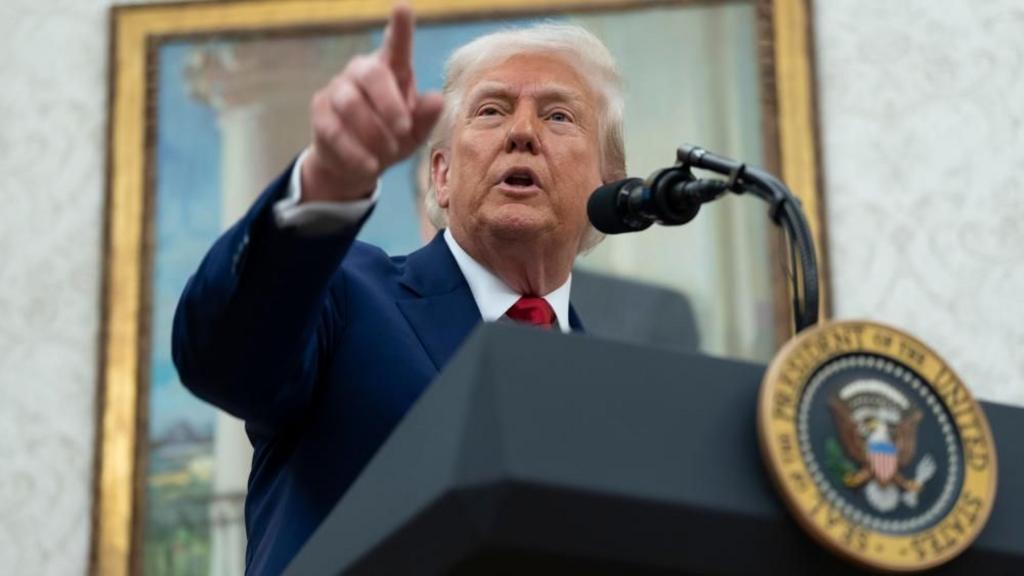Trump’s Tariffs Still Stand as US Court Gives Temporary Go-Ahead
US President Donald Trump wins a court battle to keep his import taxes for now, as businesses and states wait for final decision

US President Donald Trump has scored a temporary victory in his ongoing battle to keep collecting import taxes, known as tariffs, on goods coming into the United States. This development follows a decision by a federal appeals court to allow the tariffs to remain in place, even though a lower court had just ruled that the majority of them were illegal.
The case began when a special trade court in New York ruled on Wednesday that President Trump had “overstepped his power” by imposing tariffs on products from countries such as China, Mexico, and Canada.
The court explained that the law President Trump used to justify these tariffs—the International Emergency Economic Powers Act of 1977—does not give the president the right to set such broad tariffs without the approval of Congress.
The ruling stated,
“The political branches, not courts, make foreign policy and chart economic policy,”
but also made it clear that only Congress has the authority to make such big decisions about trade.
If the lower court’s order had taken effect immediately, it would have stopped Trump’s new tariffs, including a 10% tax on imports from many countries and higher so-called “reciprocal tariffs” on products from the European Union and China.
However, tariffs on cars, steel, and aluminium—which Trump justified for “national security” reasons under a different law—were not affected by this ruling.
President Trump was not pleased with the trade court’s decision. He reacted strongly on social media, calling it a “horrible, Country threatening decision” and urging the Supreme Court to reverse it “QUICKLY and DECISIVELY.”

White House spokesperson Karoline Leavitt echoed this sentiment at a press briefing, saying,
“America cannot function if President Trump, or any other president, for that matter, has their sensitive diplomatic or trade negotiations railroaded by activist judges.”
The Trump administration argued that the court’s decision would “improperly second-guess the president and threaten to unravel months of hard-fought trade negotiations.”
Just a day after the lower court’s decision, the federal appeals court stepped in and granted the White House’s request to temporarily suspend the order.
This means that the tariffs can remain in place for now while the legal battle continues. The next hearing in this high-profile case is set for June 5.
Many small businesses and several states have challenged Trump’s tariffs, saying that the constant changes make it very difficult to plan for the future and increase the cost of doing business.
Kara Dyer, the owner of a toy company that imports products from China, shared her frustration:
“It’s just been so chaotic and so impossible to plan as a business. I was incredibly happy and relieved but I’m also still very cautious. I want this to work its way through our court system so we have a little bit more certainty about what tariffs will be in the future.”
The uncertainty is affecting not just business owners, but also consumers, who may have to deal with higher prices if the tariffs remain.
Experts say that even if the lower court’s ruling is eventually upheld, tariffs on cars, steel, and aluminium will continue, costing the average American household nearly $1,000 this year. If the broader tariffs are brought back, families could lose up to $2,800 in purchasing power due to increased prices.
Legal experts are divided on what might happen next. Some believe the courts may ultimately side with Congress’s constitutional authority over trade, while others point out that courts often give the president the “benefit of the doubt” on issues related to national security and foreign policy.
Terry Haines, founder of Pangaea Policy, said he thinks
“the president is probably going to be given the benefit of the doubt” by the courts.
On the other hand, Ilya Somin, a lawyer who helped work on the case, said he is “guardedly optimistic” that the court’s ruling will be upheld, noting that the trade court order came from justices appointed by both Democratic and Republican presidents, including one appointed by Trump himself.
If the courts eventually block Trump’s tariffs, the president still has other legal options. He could use Section 232 of the Trade Expansion Act of 1962 to impose tariffs for national security reasons, or Section 301 of the Trade Act of 1974 for unfair trade practices, as he did during his first term with China.
There is even a 1930 trade law—Section 338 of the Trade Act—which allows the president to impose tariffs of up to 50% on imports from countries that “discriminate” against the US, though this law has not been used for decades.
Dmitry Grozoubinski, a former trade negotiator, said the court battle has weakened Trump’s ability to use tariffs as a tool for leverage over other countries.
He explained, “It will be a lot harder for him to raise tariffs in the future. This was ultimately a negotiation in which President Trump was threatening other countries with a big stick and that stick just got considerably more ephemeral.”
For now, President Trump’s tariffs remain in place, but the final decision will come from the courts. Businesses and consumers in the United States are watching closely, hoping for more certainty in the coming weeks. As Kara Dyer put it, “I want this to work its way through our court system so we have a little bit more certainty about what tariffs will be in the future.”
Stay Woke, Stay Tuned. Stay with AKEWE NEWS.




